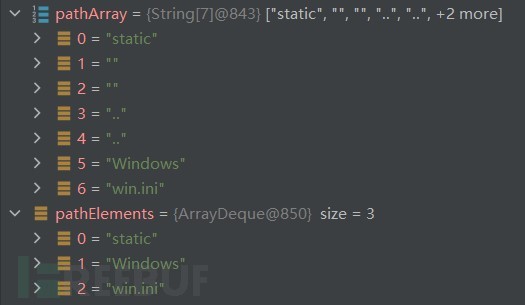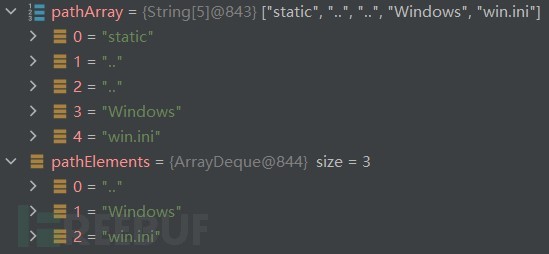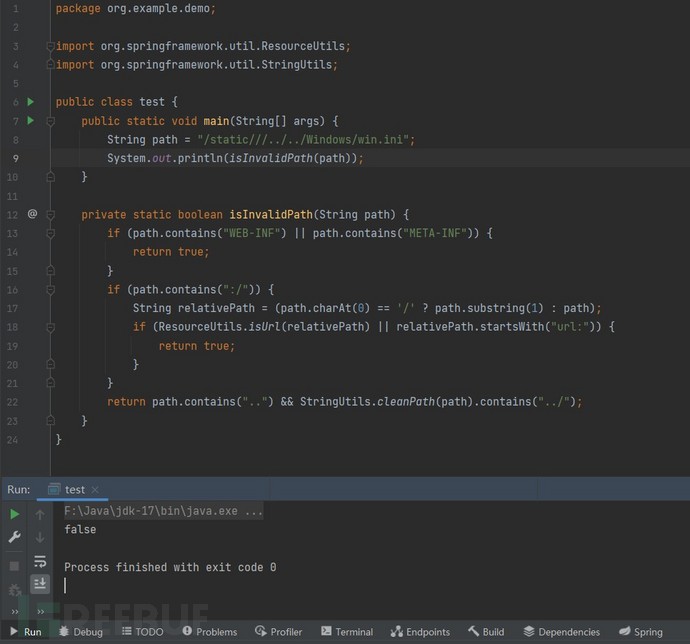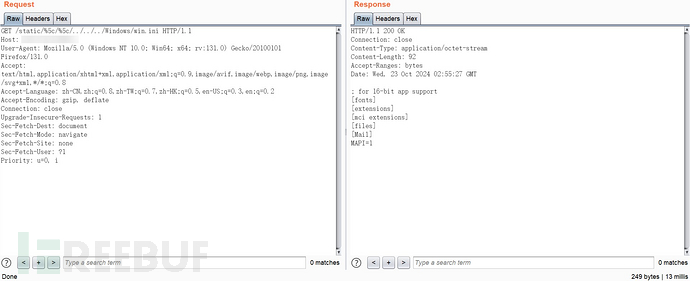漏洞概述
VMware Spring Framework是美国威睿(VMware)公司的一套开源的Java、JavaEE应用程序框架。该框架可帮助开发人员构建高质量的应用。
近期,网宿安全演武实验室监测到Spring Framework在特定条件下,存在目录遍历漏洞(网宿评分:高危、CVSS 3.1 评分:7.5):
当同时满足使用 RouterFunctions 和 FileSystemResource 来处理和提供静态文件时,攻击者可构造恶意请求遍历读取系统上的文件。
目前该漏洞POC状态已在互联网公开,建议客户尽快做好自查及防护。
受影响版本
Spring Framework 5.3.0 - 5.3.39
Spring Framework 6.0.0 - 6.0.23
Spring Framework 6.1.0 - 6.1.12
其他更旧或者官方已不支持的版本
漏洞分析
根据漏洞描述(https://spring.io/security/cve-2024-38816)可知,关键变更在于如何处理静态资源路径。
这里改了两处,分别是:
webflux --> org.springframework.web.reactive.function.server.PathResourceLookupFunction
webmvc --> org.springframework.web.servlet.function.PathResourceLookupFunction
它们都旨在为 Web 应用程序提供静态内容的访问。
以webmvc --> org.springframework.web.servlet.function.PathResourceLookupFunction为例,展开分析。
先是动态处理了资源请求,确保只返回有效并且可访问的资源。
@Override
public Optional<Resource> apply(ServerRequest request) {
PathContainer pathContainer = request.requestPath().pathWithinApplication();
if (!this.pattern.matches(pathContainer)) {
return Optional.empty();
}
pathContainer = this.pattern.extractPathWithinPattern(pathContainer);
String path = processPath(pathContainer.value());
if (path.contains("%")) {
path = StringUtils.uriDecode(path, StandardCharsets.UTF_8);
}
if (!StringUtils.hasLength(path) || isInvalidPath(path)) {
return Optional.empty();
}
try {
Resource resource = this.location.createRelative(path);
if (resource.isReadable() && isResourceUnderLocation(resource)) {
return Optional.of(resource);
}
else {
return Optional.empty();
}
}
catch (IOException ex) {
throw new UncheckedIOException(ex);
}
}接着对路径字符串进行规范化处理,确保返回的路径格式是有效的。
private String processPath(String path) {
boolean slash = false;
for (int i = 0; i < path.length(); i++) {
if (path.charAt(i) == '/') {
slash = true;
}
else if (path.charAt(i) > ' ' && path.charAt(i) != 127) {
if (i == 0 || (i == 1 && slash)) {
return path;
}
path = slash ? "/" + path.substring(i) : path.substring(i);
return path;
}
}
return (slash ? "/" : "");
}最后从安全角度,确保路径不指向敏感目录,并且避免出现路径穿越的情况。
private boolean isInvalidPath(String path) {
if (path.contains("WEB-INF") || path.contains("META-INF")) {
return true;
}
if (path.contains(":/")) {
String relativePath = (path.charAt(0) == '/' ? path.substring(1) : path);
if (ResourceUtils.isUrl(relativePath) || relativePath.startsWith("url:")) {
return true;
}
}
return path.contains("..") && StringUtils.cleanPath(path).contains("../");
}简单阐明以后,不难发现上述代码做了敏感目录检查、url检查、路径穿越检查等操作,暂时没发现可疑点,所以我们需要进一步跟进
org.springframework.web.servlet.function.PathResourceLookupFunction#isInvalidPath()
查看一下它检查相对路径时,StringUtils.cleanPath()做了哪些操作。
public static String cleanPath(String path) {
if (!hasLength(path)) {
return path;
}
String normalizedPath;
// Optimize when there is no backslash
if (path.indexOf('\\') != -1) {
normalizedPath = replace(path, DOUBLE_BACKSLASHES, FOLDER_SEPARATOR);
normalizedPath = replace(normalizedPath, WINDOWS_FOLDER_SEPARATOR, FOLDER_SEPARATOR);
}
else {
normalizedPath = path;
}
String pathToUse = normalizedPath;
// Shortcut if there is no work to do
if (pathToUse.indexOf('.') == -1) {
return pathToUse;
}
// Strip prefix from path to analyze, to not treat it as part of the
// first path element. This is necessary to correctly parse paths like
// "file:core/../core/io/Resource.class", where the ".." should just
// strip the first "core" directory while keeping the "file:" prefix.
int prefixIndex = pathToUse.indexOf(':');
String prefix = "";
if (prefixIndex != -1) {
prefix = pathToUse.substring(0, prefixIndex + 1);
if (prefix.contains(FOLDER_SEPARATOR)) {
prefix = "";
}
else {
pathToUse = pathToUse.substring(prefixIndex + 1);
}
}
if (pathToUse.startsWith(FOLDER_SEPARATOR)) {
prefix = prefix + FOLDER_SEPARATOR;
pathToUse = pathToUse.substring(1);
}
String[] pathArray = delimitedListToStringArray(pathToUse, FOLDER_SEPARATOR);
// we never require more elements than pathArray and in the common case the same number
Deque<String> pathElements = new ArrayDeque<>(pathArray.length);
int tops = 0;
for (int i = pathArray.length - 1; i >= 0; i--) {
String element = pathArray[i];
if (CURRENT_PATH.equals(element)) {
// Points to current directory - drop it.
}
else if (TOP_PATH.equals(element)) {
// Registering top path found.
tops++;
}
else {
if (tops > 0) {
// Merging path element with element corresponding to top path.
tops--;
}
else {
// Normal path element found.
pathElements.addFirst(element);
}
}
}
// All path elements stayed the same - shortcut
if (pathArray.length == pathElements.size()) {
return normalizedPath;
}
// Remaining top paths need to be retained.
for (int i = 0; i < tops; i++) {
pathElements.addFirst(TOP_PATH);
}
// If nothing else left, at least explicitly point to current path.
if (pathElements.size() == 1 && pathElements.getLast().isEmpty() && !prefix.endsWith(FOLDER_SEPARATOR)) {
pathElements.addFirst(CURRENT_PATH);
}
final String joined = collectionToDelimitedString(pathElements, FOLDER_SEPARATOR);
// avoid string concatenation with empty prefix
return prefix.isEmpty() ? joined : prefix + joined;
}这个方法主要对用户输入路径做了规范化处理,具体包括长度检查、不同操作系统下的路径分隔符处理等。看起来也做了严格的处理,但这一步存在问题。
String[] pathArray = delimitedListToStringArray(pathToUse, FOLDER_SEPARATOR);具体来说,它是允许空元素存在的,假设路径字符串形如:
String pathToUse = "/static///../../Windows/win.ini";
那么调用 delimitedListToStringArray 方法以后,pathArray即为
["static", "", "", "..", "..", "Windows", "win.ini"]
而pathElements即为

再来看这一串:String pathToUse = "/static/../../Windows/win.ini";

显然,pathArray中存在空元素会影响上级目录的处理,导致返回不同的结果,即存在安全隐患。
漏洞复现
实现目录穿越需要用到"../",结合上述分析,可通过这种方式实现。
package org.example.demo;
import org.springframework.util.ResourceUtils;
import org.springframework.util.StringUtils;public class test {
public static void main(String[] args) {
String path = "/static///../../Windows/win.ini";
System.out.println(isInvalidPath(path));
}private static boolean isInvalidPath(String path) {
if (path.contains("WEB-INF") || path.contains("META-INF")) {
return true;
}
if (path.contains(":/")) {
String relativePath = (path.charAt(0) == '/' ? path.substring(1) : path);
if (ResourceUtils.isUrl(relativePath) || relativePath.startsWith("url:")) {
return true;
}
}
return path.contains("..") && StringUtils.cleanPath(path).contains("../");
}
}

但还需要结合上下文,继续构造payload。首先路径以斜杠开头时,StringUtils.cleanPath()方法会去掉路径的第⼀个斜杠。
if (pathToUse.startsWith(FOLDER_SEPARATOR)) {
prefix = prefix + FOLDER_SEPARATOR;
pathToUse = pathToUse.substring(1);
}那就需要多写一条"/",构造"///../"跳一级目录。
而在最初的org.springframework.web.servlet.function.PathResourceLookupFunction#apply()中,对路径做了规范化处理,即去掉连续的"/"
pathContainer = this.pattern.extractPathWithinPattern(pathContainer);
String path = processPath(pathContainer.value());所以需要将多余的"/"变为"\",再借助StringUtils.cleanPath()方法重新转换回来。
normalizedPath = replace(normalizedPath, WINDOWS_FOLDER_SEPARATOR, FOLDER_SEPARATOR);
修复方案
目前官方已有可更新版本,建议受影响用户升级至最新版本:
https://github.com/spring-projects/spring-framework/tags
4A评测 - 免责申明
本站提供的一切软件、教程和内容信息仅限用于学习和研究目的。
不得将上述内容用于商业或者非法用途,否则一切后果请用户自负。
本站信息来自网络,版权争议与本站无关。您必须在下载后的24个小时之内,从您的电脑或手机中彻底删除上述内容。
如果您喜欢该程序,请支持正版,购买注册,得到更好的正版服务。如有侵权请邮件与我们联系处理。敬请谅解!
程序来源网络,不确保不包含木马病毒等危险内容,请在确保安全的情况下或使用虚拟机使用。
侵权违规投诉邮箱:4ablog168#gmail.com(#换成@)

